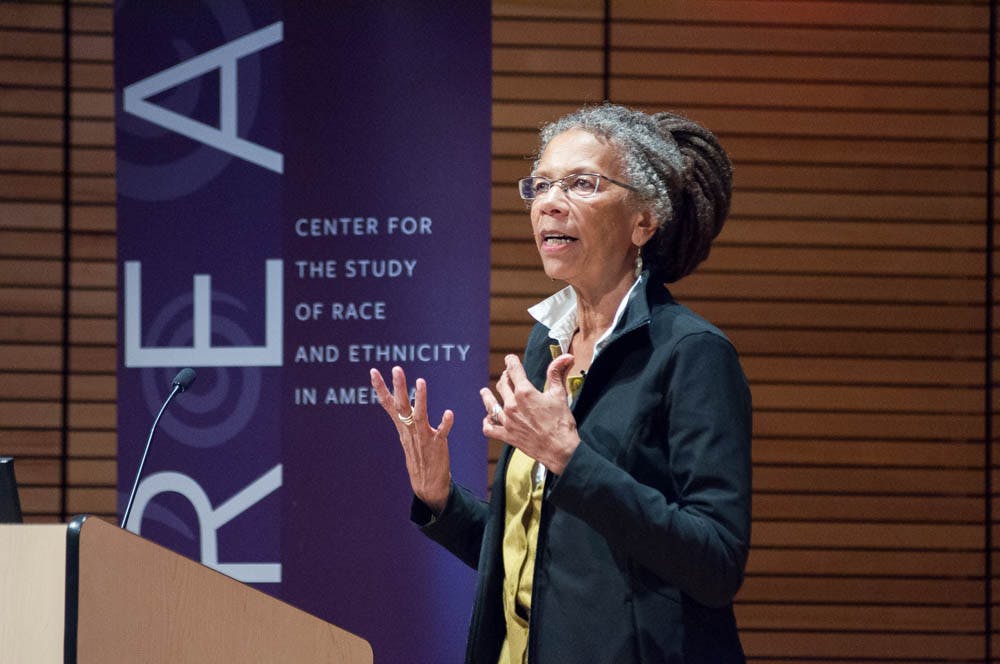Structural racism is a system “whose transformative properties have to be changed because we’re living in it; we’re not across the street from it,” said Ruth Wilson Gilmore, director of the Center for Place, Culture and Politics at the City University of New York, Thursday night at an event in the Granoff Center’s Martinos Auditorium. Gilmore’s lecture on industrialized punishment was the seventh in a seven-part series called “How Structural Racism Works.”
The series was organized by Tricia Rose, professor of Africana studies, associate dean of the faculty for special initiatives and the director of the Center for the Study of Race and Ethnicity in America. The goal of the series was “to learn about one of the most — if not the most — pressing challenges facing our society,” said Provost Richard Locke P’17. The program was launched because “we were, ourselves, as a community, grappling with issues of race and racism,” Locke said.
The United States is first in both rate and absolute number of people incarcerated, Gilmore said. There are about 700 inmates per every one million people in the general population. In addition to the 2.4 million people locked up, there are another seven to eight million people under supervision, she added.
There are 65 million people in this country who, because of convictions, are “forbidden from having certain kinds of jobs, and the jobs tend to be the very kinds of jobs that modestly educated people” can have, Gilmore said.
Gilmore framed her talk on industrialized punishment into four components: land, labor, capital and legal authority.
The first component is “changing the combination of particular kinds of people using particular kinds of land,” she said, referring to the gentrification of both urban and rural spaces.
The second component of industrialized punishment is labor, a phenomenon in which waves of “modestly educated people in the prime of life” are cut loose from livable employment when they are imprisoned and are no longer able to support their families. Subsequently, people who are formerly incarcerated are denied eligibility for certain jobs, and the box on job applications asking if someone has been convicted of a felony perpetuates discrimination.
The “Ban the Box” movement has gained prominence among student activists. Student demands with regard to the Diversity and Inclusion Action Plan included a request to remove the box from Brown’s application.
The third component is capital, meaning the shift in the use of public funds from public schooling and welfare to insidious fortifications for the incarceration system, Gilmore said.
The last component for industrialized punishment is the legal authority for the state to organize these systems. While decisions made by President Lyndon B. Johnson and President Bill Clinton are broadly viewed as responsible for the development of mass incarceration, the “United States criminal justice system is made up of 53 jurisdictions for prisons (and) 3,100 for county jails,” which also have a hand in industrialized punishment, Gilmore said. Each one of these jurisdictions passes and enforces laws that perpetuate the system of mass incarceration.
Structural racism also stems from our capitalist system, Gilmore said. Capitalism relies on organized hierarchies, which are linked with racialized thinking, Gilmore said.
Gilmore compared the prison-industrial complex to the military-industrial complex in that it requires potential enemies “who must always be fought and can never be vanquished.” There is a vested interest for vendors that supply prisons, as well as for the workers employed by them, to maintain mass incarceration and its revenues.
The majority of the money spent on mass incarceration goes to wages and salaries, Gilmore said, adding that it is a service industry that requires mass employment to run. The second greatest expenditure goes toward paying debts, as prisons have been required to expand to meet health and safety standards as the number of inmates grows.
While people view private prisons as the biggest beneficiary of mass incarceration, “there are other private corporations that are beneficiaries of the fact that humans — on a scale unprecedented in the world — are locked up in cages,” Gilmore said. Vendors providing food, telephone service, video visits and canteens to prisoners can manipulate prices. Because only authorized dealers can provide these goods, the vendors add huge markups.
“Capitalism requires inequality, and racism enshrines inequality,” Gilmore said.





